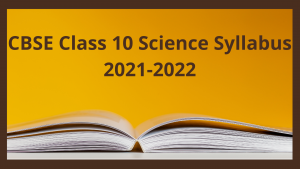CBSE Class 10 Science Syllabus 2021-2022
CBSE ने घोषणा की है कि वह प्रत्येक में 50% पाठ्यक्रम का उपयोग करके दो भागों में बोर्ड परीक्षा आयोजित करेगा। बोर्ड ने दोनों शर्तों के लिए तर्कसंगत पाठ्यक्रम जारी किया है; मैं और द्वितीय। हमने 24 जुलाई को जारी नए संशोधित पाठ्यक्रम को डाउनलोड करने के लिए लिंक नीचे दिया है .

Check Course Structure for Class 10 Science (Annual Examination):
| Unit No. | Unit Name | Marks |
| I | Chemical Substances-Nature and Behaviour | 25 |
| II | World of Living | 23 |
| III | Natural Phenomena | 12 |
| IV | Effects of Current | 13 |
| V | Natural Resources | 07 |
| Total | 80 | |
| Internal Assessment | 20 | |
| Grand Total | 100 |
Unit I: Chemical Substances – Nature and Behaviour
Chemical reactions:
Chemical equation, Balanced chemical equation, implications of a balanced chemical equation, types of chemical reactions: combination, decomposition, displacement, double displacement, precipitation, neutralization, oxidation and reduction. Acids, bases and salts: Their definitions in terms of furnishing of H+ and OH– ions, General properties, examples and uses, concept of pH scale (Definition relating to logarithm not required), importance of pH in everyday life; preparation and uses of Sodium Hydroxide, Bleaching powder, Baking soda, Washing soda and Plaster of Paris.
Metals and nonmetals:
Properties of metals and non-metals; Reactivity series; Formation and properties of ionic compounds; Basic metallurgical processes; Corrosion and its prevention.
Carbon compounds:
Covalent bonding in carbon compounds. Versatile nature of carbon. Homologous series. Nomenclature of carbon compounds containing functional groups (halogens, alcohol, ketones, aldehydes, alkanes and alkynes), difference between saturated hydro carbons and unsaturated hydrocarbons. Chemical properties of carbon compounds (combustion, oxidation, addition and substitution reaction). Ethanol and Ethanoic acid (only properties and uses), soaps and detergents.
Periodic classification of elements:
Need for classification, early attempts at classification of elements (Dobereiner’s Triads, Newland’s Law of Octaves, Mendeleev’s Periodic Table), Modern periodic table, gradation in properties, valency, atomic number, metallic and non-metallic properties.
Theme: The World of the Living
Unit II: World of Living
Life processes:
‘Living Being’. Basic concept of nutrition, respiration, transport and excretion in plants and animals. Control and co-ordination in animals and plants: Tropic movements in plants; Introduction of plant hormones.
Control and co-ordination in animals:
Nervous system; Voluntary, involuntary and reflex action; Chemical co-ordination: animal hormones.
Reproduction:
Reproduction in animals and plants (asexual and sexual) reproductive health-need and methods of family planning. Safe sex vs HIV/AIDS. Child bearing and women’s health.
Heredity and Evolution:
Heredity; Mendel’s contribution- Laws for inheritance of traits: Sex determination: brief introduction; Basic concepts of evolution.
Theme: Natural Phenomena
Unit III: Natural Phenomena
Reflection of light by curved surfaces; Images formed by spherical mirrors, centre of curvature, principal axis, principal focus, focal length, mirror formula (Derivation not required), magnification. Refraction; Laws of refraction, refractive index. Refraction of light by spherical lens; Image formed by spherical lenses; Lens formula (Derivation not required); Magnification. Power of a lens. Functioning of a lens in human eye, defects of vision and their corrections, applications of spherical mirrors and lenses. Refraction of light through a prism, dispersion of light, scattering of light, applications in daily life.
Theme: How Things Work
Unit IV: Effects of Current
Electric current, potential difference and electric current. Ohm’s law; Resistance, Resistivity, Factors on which the resistance of a conductor depends. Series combination of resistors, parallel combination of resistors and its applications in daily life. Heating effect of electric current and its applications in daily life. Electric power, Interrelation between P, V, I and R.
Magnetic effects of current:
Magnetic field, field lines, field due to a current carrying conductor, field due to current carrying coil or solenoid; Force on current carrying conductor, Fleming’s Left Hand Rule, Electric Motor, Electromagnetic induction. Induced potential difference, Induced current. Fleming’s Right Hand Rule, Electric Generator, Direct current. Alternating current: frequency of AC. Advantage of AC over DC. Domestic electric circuits.
Theme: Natural Resources
Unit V: Natural Resources
Sources of energy:
Different forms of energy, conventional and non-conventional sources of energy: Fossil fuels, solar energy; biogas; wind, water and tidal energy; Nuclear energy. Renewable versus non-renewable sources of Energy.
Our environment:
Eco-system, Environmental problems, Ozone depletion, waste production and their solutions. Biodegradable and non-biodegradable substances.
Management of natural resources:
Conservation and judicious use of natural resources. Forest and wild life; Coal and Petroleum conservation. Examples of people’s participation for conservation of natural resources. Big dams: advantages and limitations; alternatives, if any. Water harvesting. Sustainability of natural resources.
Download Here 10th Science Syllabus – Click Here
Also Check :: CBSE Class 10 Maths Syllabus 2021-2022